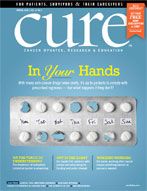Publication
Article
CURE
The Skinny on Soy
Author(s):
Moderate consumption of soy-based foods may lower the risk of breast cancer or recurrence.
Soy has been touted as a wonder food, as it’s high in fiber, potassium and protein. It’s often used as a meat substitute, which could ultimately lower overall cancer risk in individuals who use it to replace their red meat intake. The low incidence of breast cancer in cultures with high soy consumption, particularly in Asian countries, also has led to the theory that soy lowers breast cancer risk.
But a diet high in soy has also been associated with cancer risk because it contains isoflavones, a type of phytoestrogen that has a similar structure to estrogen and binds to the estrogen receptor. Might women with a high risk of breast cancer or a past diagnosis of estrogen-positive breast cancers increase their risk by consuming large amounts of soy?
The potential association between soy and breast cancer initially came to light in the 1990s after a rodent study showed an increase in hormone-positive breast cancer incidence after rats were fed high doses of isoflavones. It seemed to make sense that foods high in phytoestrogens could impact the growth of breast cancer cells fueled by estrogen.
But experts now say it’s a large leap to go from the effects of high supplemental doses of a soy compound in rats to an effect in humans.
If anything, recent research has shown that it is associated with a lower risk of breast cancer, and for women who have had breast cancer, with a lower risk of recurrence, says Peggy Mancini, a clinical dietitian at City of Hope in Duarte, California.
A large-scale study found that women who consumed natural sources of soy had a lower risk of breast cancer than individuals who did not consume soy. The study, which was published in 2014 in the American Journal of Clinical Nutrition, found that of the nearly 10,000 women surveyed, those who consumed soy after a breast cancer diagnosis had a 25 percent lower risk of recurrence after about seven years. Other evidence points to a reduced cancer risk if soy is consumed during childhood and adolescence. Additional findings have shown that certain dietary factors, including soy consumption, decreased the risk of death from all causes in breast cancer survivors and possibly survivors of other cancers, according to Marjorie L. McCullough, strategic director of nutritional epidemiology for the American Cancer Society.
Finally, other studies have found additional health effects, including cardiovascular benefit, a lower risk of colon cancer and decreased PSA levels in prostate cancer survivors. There has not been a confirmed association, and studies have yielded mixed results, but soy may also alleviate symptoms of menopause, including hot flashes.
Experts recommend moderate soy consumption, as with most foods and beverages. A diet high in soy could include soy beans, tofu, tempeh, edamame, soy yogurt and soy milk.
In fact, Mancini recommends soy milk over other milk alternatives. “It’s closer to animal milk than are almond or rice milk, which don’t have the protein soy milk has,” she says.
McCullough, whose research has focused on the role of dietary factors in relation to cancer risk, emphasizes that people should consume their soy through whole foods, not supplements.
“So far, in the studies in humans, observational studies, people were eating soy foods and some were taking supplements,” although not enough to sufficiently draw conclusions about the pros and cons of supplementation, she says. “We just don’t have the data. At the American Cancer Society, we don’t recommend that people take (soy) supplements because we just don’t have the evidence that it’s safe.





